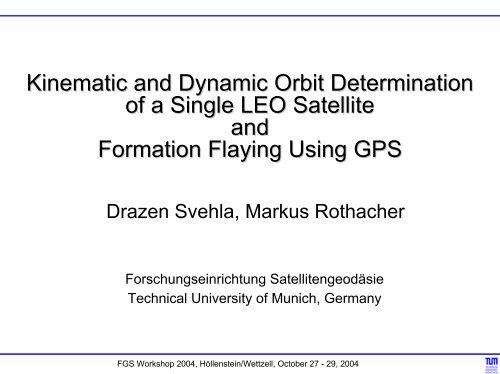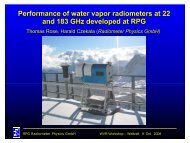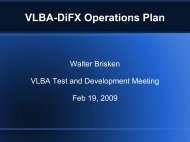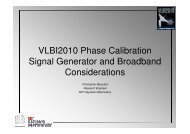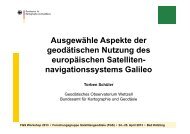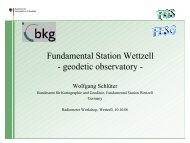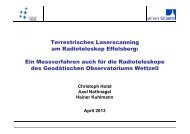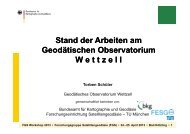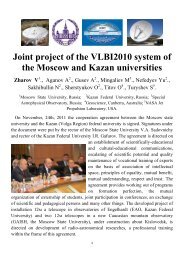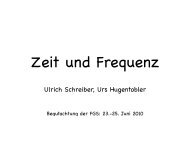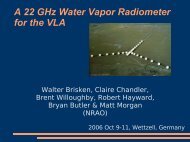GRACE-A and GRACE-B together
GRACE-A and GRACE-B together
GRACE-A and GRACE-B together
Create successful ePaper yourself
Turn your PDF publications into a flip-book with our unique Google optimized e-Paper software.
Kinematic <strong>and</strong> Dynamic Orbit Determination<br />
of a Single LEO Satellite<br />
<strong>and</strong><br />
Formation Flaying Using GPS<br />
Drazen Svehla, Markus Rothacher<br />
Forschungseinrichtung Satellitengeodäsie<br />
Technical University of Munich, Germany<br />
FGS Workshop 2004, Höllenstein/Wettzell, October 27 - 29, 2004
Content<br />
• Kinematic positioning of IGS stations, LEOs <strong>and</strong> GPS satellites<br />
• Positioning with phase GPS satellite clocks<br />
• CHAMP <strong>and</strong> <strong>GRACE</strong> kinematic & reduced-dynamic POD over 2 years<br />
• Reduced-kinematic POD<br />
• POD based on LP linear combination (one-frequency LEO GPS data)<br />
• CHAMP <strong>and</strong> Ionosphere<br />
• POD strategies for LEO formation flying<br />
• Ambiguity resolution with <strong>GRACE</strong><br />
• Combined GPS/KBR kinematic & dynamic baseline in space<br />
FGS Workshop 2004, Höllenstein/Wettzell, October 27 - 29, 2004
FGS Workshop 2004, Höllenstein/Wettzell, October 27 - 29, 2004<br />
Kinematic IGS Station<br />
Baseline ALGO-GODE (length 777 km)<br />
Double-differences with fixed ambiguities<br />
(Melbourne-Wübbena with narrow-laning)<br />
Differences between kinematic positions<br />
estimated every 30 s for GODE IGS station<br />
<strong>and</strong> weekly GODE coordinates<br />
All global products kept fixed. Similar results<br />
with troposphere estimation.
FGS Workshop 2004, Höllenstein/Wettzell, October 27 - 29, 2004<br />
Kinematic GPS Satellite<br />
PRN 20<br />
Baselines IGS-GPS (length up to 1000 km)<br />
Double-differences with flixed ambiguities.<br />
Differences between kinematic positions<br />
estimated every 30 s for GPS Satellite<br />
PRN 20 <strong>and</strong> dynamic orbit<br />
All global products were kept fixed,<br />
except orbit of GPS satellite PRN 20,<br />
day 200/2002.
FGS Workshop 2004, Höllenstein/Wettzell, October 27 - 29, 2004<br />
Kinematic <strong>GRACE</strong>-A<br />
Differences between kinematic <strong>and</strong><br />
reduced-dynamic positions.<br />
All global products were kept fixed,<br />
day 200/2003.<br />
Zero-difference phase measurements.
GPS Clocks<br />
Estimation of the 5-min <strong>and</strong> the 30-s phase GPS clocks<br />
using 40 IGS stations<br />
Selection of the reference clock (BRUS, USNO or WTZR)<br />
Alignment of the reference clock to the broadcast GPS clocks<br />
(daily bias <strong>and</strong> drift estimation)<br />
Pre-processing of the phase/code data<br />
based on Melbourne-Wübbena LC<br />
Estimation of the 5-min GPS clocks only to clean data<br />
using code <strong>and</strong> phase measurements<br />
Pre-processing of the phase data<br />
using the 5-min GPS clocks<br />
Estimation of the 30-s GPS clocks<br />
using phase measurements <strong>and</strong> code measurements (only reference station)<br />
- normal equation matrix with up to 5000 phase ambiguities<br />
FGS Workshop 2004, Höllenstein/Wettzell, October 27 - 29, 2004
GPS Phase Clocks<br />
FGS Workshop 2004, Höllenstein/Wettzell, October 27 - 29, 2004
Positioning of the CHAMP Satellite: Two Years<br />
Daily RMS difference between kinematic <strong>and</strong> reduced-dynamic orbit<br />
FGS Workshop 2004, Höllenstein/Wettzell, October 27 - 29, 2004
Kinematic Positioning <strong>and</strong><br />
Gravity Field Recovery<br />
Users of the CHAMP 2-Year Kinematic Orbits<br />
Austria (gravity)<br />
Canada (gravity)<br />
China (gravity/POD)<br />
Denmark (gravity)<br />
Germany (gravity/POD)<br />
Japan (POD)<br />
Netherl<strong>and</strong>s (gravity/POD)<br />
Switzerl<strong>and</strong> (POD)<br />
Taiwan (gravity/POD)<br />
UK (gravity)<br />
US (POD)<br />
FGS Workshop 2004, Höllenstein/Wettzell, October 27 - 29, 2004
Positioning of the <strong>GRACE</strong> Satellites: Two Years<br />
FGS Workshop 2004, Höllenstein/Wettzell, October 27 - 29, 2004
Daily RMS difference between kinematic <strong>and</strong> reduced-dynamic orbit<br />
<strong>GRACE</strong>-A POD over 4 months <strong>GRACE</strong>-B<br />
FGS Workshop 2004, Höllenstein/Wettzell, October 27 - 29, 2004
Validation with SLR<br />
<strong>GRACE</strong>-A <strong>GRACE</strong>-B<br />
Reduced-Dynamic Orbit<br />
FGS Workshop 2004, Höllenstein/Wettzell, October 27 - 29, 2004<br />
Reduced-Dynamic Orbit<br />
Kinematic Orbit Kinematic Orbit<br />
Day of year<br />
Day of year<br />
Day of year
FGS Workshop 2004, Höllenstein/Wettzell, October 27 - 29, 2004<br />
Reduced-Kinematic POD<br />
Kinematic POD with dynamic information in<br />
order to reduce influence of weak<br />
geometry <strong>and</strong> phase breaks (jumps).<br />
Methods:<br />
• Absolute constraints to the a priori orbit<br />
• Relative constraints between epochs<br />
• Gauss-Markov process<br />
Normal system solution:<br />
• Full normal matrix inversion<br />
(86400 kinematic coordinates for one-day arc)<br />
• L - U factorization<br />
(block tridiagonal system), block forward<br />
elimination <strong>and</strong> back substitution.<br />
Characteristics:<br />
Smoothing effect
Reduced-Kinematic POD<br />
FGS Workshop 2004, Höllenstein/Wettzell, October 27 - 29, 2004
FGS Workshop 2004, Höllenstein/Wettzell, October 27 - 29, 2004<br />
POD Based on<br />
LP Linear Combination<br />
Linear combination of phase <strong>and</strong> code<br />
measurements on one frequency.<br />
LP=(L1+P1)/2<br />
Ionosphere effect eliminated.<br />
Wavelength ≈ 95 mm<br />
Reduction of P-code noise by a factor of 2.<br />
Pre-processing more difficult.
CHAMP <strong>and</strong> Ionosphere<br />
FGS Workshop 2004, Höllenstein/Wettzell, October 27 - 29, 2004
POD Strategies for LEO Formation Flying<br />
Combined zero & double-difference POD<br />
FGS Workshop 2004, Höllenstein/Wettzell, October 27 - 29, 2004
Ambiguity resolution with <strong>GRACE</strong> baseline<br />
Total number of ambiguities, mean= 416<br />
FGS Workshop 2004, Höllenstein/Wettzell, October 27 - 29, 2004<br />
Resolved narrow-lane ambiguities using<br />
kinematic bootstrapping, mean= 93.6%<br />
Day of year Day of year<br />
Resolved wide-lane ambiguities<br />
(Melbourne-Wübbena), mean= 98.4%<br />
Day of year<br />
Resolved narrow-lane ambiguities using<br />
dynamic bootstrapping, mean= 92.8%<br />
Day of year
Zero-difference orbits<br />
(like two CHAMP satellites)<br />
<strong>GRACE</strong> Formation Flying<br />
Zero-differences versus<br />
combined zero&double-difference reduced-dyn.<br />
orbits, validation with KBR<br />
FGS Workshop 2004, Höllenstein/Wettzell, October 27 - 29, 2004<br />
Float ambiguities<br />
(<strong>GRACE</strong>-A <strong>and</strong> <strong>GRACE</strong>-B <strong>together</strong>)<br />
RMS=15.7 mm RMS=11.6 mm<br />
Time in hours RMS=2.8 mm<br />
Time in hours<br />
Time in hours<br />
Fixed ambiguities<br />
(<strong>GRACE</strong>-A <strong>and</strong><br />
<strong>GRACE</strong>-B <strong>together</strong>)
Baseline Validation with KBR<br />
Reduced-Dynamic Orbit Kinematic Orbit<br />
Float ambiguities<br />
RMS= 15.1 mm RMS= 11.7 mm<br />
Time in hours Time in hours<br />
RMS= 3.0 mm<br />
Time in hours<br />
pseudo-stochastic<br />
pulses<br />
Fixed ambiguities<br />
FGS Workshop 2004, Höllenstein/Wettzell, October 27 - 29, 2004<br />
RMS= 6.1 mm<br />
Time in hours
Validation with KBR<br />
Reduced-Dynamic Orbit Kinematic Orbit<br />
Zero-differences<br />
RMS= 12.6 mm<br />
RMS= 15.0 mm<br />
Time in hours Time in hours<br />
Kinematic/Reduced-Dynamic Orbit<br />
Double-differences<br />
fixed ambiguities<br />
FGS Workshop 2004, Höllenstein/Wettzell, October 27 - 29, 2004<br />
Reduced-Dynamic Baseline<br />
Validation with KBR<br />
Day of year Day of year
Combined GPS/KBR Baseline<br />
Kinematic/reduced-dynamic<br />
GPS Only<br />
baseline with fixed ambiguities GPS + KBR<br />
FGS Workshop 2004, Höllenstein/Wettzell, October 27 - 29, 2004
Combined GPS/KBR Baseline<br />
Impact of the KBR on the<br />
Kinematic orbit<br />
kinematic <strong>and</strong> reduced-dynamic Reduced-dynamic orbit<br />
GPS baseline with fixed ambiguities<br />
FGS Workshop 2004, Höllenstein/Wettzell, October 27 - 29, 2004<br />
pseudo-stochastic pulses
Conclusions<br />
• 1-2 cm kinematic positioning for LEO satellites <strong>and</strong> IGS stations &<br />
10 cm for GPS satellites is possible.<br />
• Kinematic POD can be used as an interface for determination of gravity field<br />
parameters <strong>and</strong> other phenomenon that govern the satellite motion.<br />
• 30-s GPS satellite clocks can be estimated with the full normal equation matrix using 40<br />
IGS stations. Positioning with the relative phase clocks has been successfuly performed.<br />
• 90%-100% of all ambiguities can be resolved for <strong>GRACE</strong> baseline using Melbourne-<br />
Wübbena wide-lanning with narrow-lane bootstrapping.<br />
• After ambiguity resolution kinematic <strong>and</strong> reduced-dynamic baseline results agree on<br />
the level of 1 cm <strong>and</strong> 3 mm respectively when validated with KBR measurements.<br />
• Combined processing of zero- <strong>and</strong> double-differences changes the orbit by 1-2 cm<br />
compared to zero-diff. case <strong>and</strong> is the optimal strategy for the LEO formation flying.<br />
• KBR <strong>and</strong> ambiguity resolution clearly shows colored noise in the kinematic positions<br />
<strong>and</strong> defficienties in the dynamic modelling.<br />
• KBR has very strong impact on the kinematic <strong>and</strong> reduced-dynamic GPS baseline<br />
even when the ambiguities are fixed.<br />
FGS Workshop 2004, Höllenstein/Wettzell, October 27 - 29, 2004


